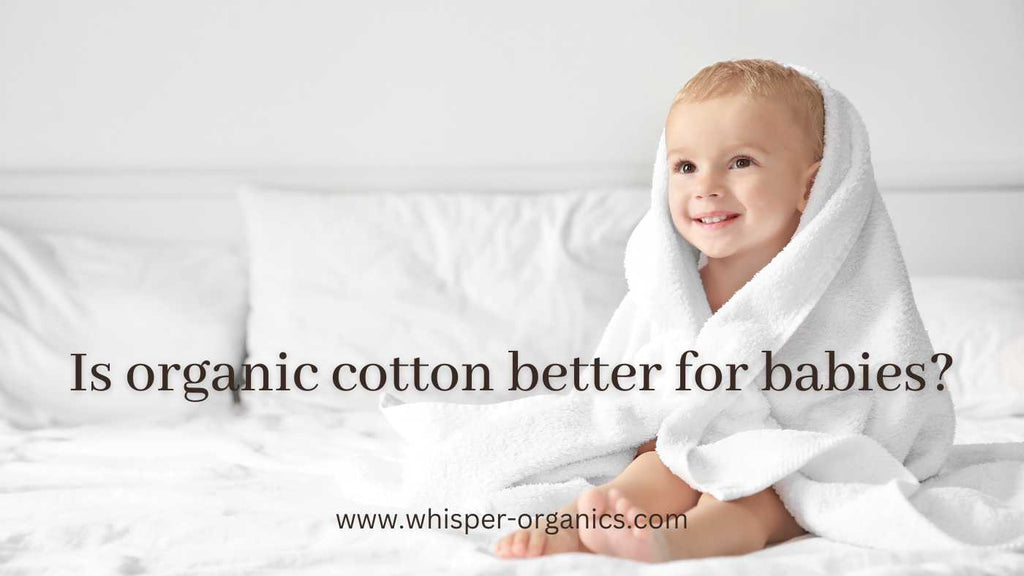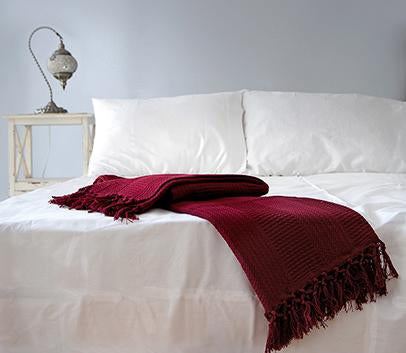
Is organic cotton better for babies?
Did you know that your baby's skin is five times thinner than yours? That is why it is sensitive to anything that touches it. So, imagine that blanket you tucked your little one in. Is it safe? That is why organic cotton is better for babies! It is a baby-friendly choice!
Scroll down and learn more about why organic cotton is better for keeping your baby safe and healthy.
Here's an overview of this blog article:
- 1. Why protect your baby's skin?
- What the skin is for
- Newborn skin versus adult skin
- What your babies' skin needs - 2. Why organic cotton is your better choice
- Organic cotton is your safer option
- Advantages of GOTS-certified organic cotton

Why protect your baby's skin?
Skin is a big deal when keeping your baby and your whole family healthy. Why is this so?
What is the skin for
Skin is skin whether you are an adult, a teener, or a baby. It is a big deal for any human being because it's the body's largest organ. Your skin's function includes:
- - It holds your body together and everything in it.
- - It is an efficient protective barrier against injuries because it is airtight, watertight, and flexible.
- - It regulates your body temperature.
- - It is your active immune organ.
- - It aids in vitamin production.
- - It helps you to sense things inside and outside your body.
Your skin is your first line of defence. With more than 3,000 possible skin disorders, protecting your skin and your baby's is essential.

Newborn skin versus adult skin
Bacteria, chemicals, and hot and cold temperatures directly affect your health when they contact your skin - for better or worse. The same goes for your baby. But here's the difference:
Baby's skin is three to five times thinner.
Your skin is about three to five times thicker than your baby's. So, you have five times more protection. Whatever touches your skin affects your baby five times more.
Harmful chemicals and synthetic fabric will trigger skin allergies in babies faster than they will affect adults. Plus, they will experience sensitive skin irritations more frequently.
The skin of your baby is more porous.
The cells of your baby's skin are five times more porous than yours. It means your baby's skin absorbs and can hold more substances because the cells are smaller and are wider apart. Any substance that your skin can hold, such as toxic materials, will be five times more for your baby.
Babies' skin is more permeable.
Permeability is measuring the ease of gas and liquid flow through something solid. Your baby's skin is more permeable than yours and is like a bigger window that can let more wind and rain pass through.
So, if left open, this bigger window will not be able to protect you from the elements. If closed well, it will do its job of keeping your family safe inside your home. Organic clothing effectively provides the extra safe covering your baby needs.

What your babies' skin needs
Babies' skin in the womb was safe and protected. It was thinner than it is now. After birth, the harsh external environment is too strong for the baby's skin. It still needs to develop, learn how to adapt to the outside world, and grow thicker.
Your babies' thin skin does not have adequate protection against hazards yet.
What can you do to provide the protection they need for now?
Keep your babies' skin clean and dry tenderly.
For your baby's first year, three baths a week is enough. Make sure that you use the mildest soap until the 24th month. Pat skin dry with organic fabric.
Be mindful of dry skin.
Use natural oils on your baby if dry and cracking skin appears. Petroleum jelly-based products are safe as they do not contain perfumes and dyes.
Limit your baby's sun exposure.
Limit your baby's exposure between 10 a.m. to 4 p.m., even in winter. The harsh UV rays can be harmful. Use natural organic clothing to cover arms and legs. Use a hat to cover the face, neck, and ears.
Use fragrance-free products.
Fragrances in shampoo, lotion, moisturizers, and even baby wipes contain harsh chemicals. Check the label to ensure that you are purchasing fragrance-free products only.
Choose hypo-allergenic clothing and bedding.
Your baby has to be wrapped with clothing and bedding that ward off allergens, ensuring not to create or worsen skin and respiratory problems. Use organic clothing for safe protection from harsh elements and harmful chemicals.
Avoid artificial perfumes and dyes.
Chemically derived perfumes and artificial dyes contain harmful chemicals that are possible irritants and allergens. Avoid them as much as possible. Check labels and information about products you use for your baby.
To sum up, protect your baby's skin because they are vulnerable to the harsh outside world. Choose organic and natural products to allow your baby to grow strongly.

Why organic cotton is your better choice
Cotton has been used as fabric since ancient times. It is popular because it is light, soft, and comfortable and allows the body to breathe even in hot and humid weather. About 75 percent of clothing products all over the world contain cotton. It also captures about 40% of the total fiber consumed worldwide.
A brief history of cotton and slavery
Its popularity is also its bane. Demand for cotton fabric made it a viable product during the industrial revolution. It was first spun in 1730 by machinery in England. Meanwhile, in America, a machine patented in the 1790s called cotton gin (gin, short for engine) could speed up cotton processing by ten times.
As cotton processing sped up, the demand for labor grew with it. Slavery was the industrialists' answer to the ever-growing demand for cotton. In the US, the slave population swelled to more than four million people in the South, supplying the Western world's need for raw cotton.
Conventional cotton and pesticides
The use of pesticides in cotton production started after the Second World War when toxic chemicals were introduced as pest control. Chemicals were cheaper and simpler compared to former agriculture practices such as crop rotation, consideration of pest cycles, and tillage.
With chemicals, production can be done whole year round. There was no need to consider pest cycles and seasonal changes. Profit margins rose and caused a dramatic global dependence on this technology.

Harmful effects of conventional cotton
Conventionally produced cotton heavily uses chemicals. It is estimated that about 80 percent of raw cotton could be lost to pests if grown without pesticides, and cotton production accounts for 25 percent of the world's use of pesticides.
On health
Prolonged exposure to conventional cotton can harm you and your baby's health. The way it kills pests is by attacking their nerves. This same effect happens to human beings. Nerve cells affected by pesticides can result in dizziness, irritated eyes, rashes, allergies, blindness, blisters, and death, to name a few.
On the environment
Cotton production has high water consumption that takes a toll on the natural balance of the environment. The heavy use of chemicals contaminates the soil and water and results in pollution and soil degradation.
So, how about your T-shirt made of conventional cotton? How many chemicals do your synthetic fabrics have? It has about 17 teaspoons of chemical fertilizers with a teaspoon of other active ingredients such as pesticides, insecticides, herbicides, and defoliants.

Organic cotton is your safer option.
Simply defined, organic cotton is any cotton that is grown and processed without chemicals. It should not be genetically engineered and has to be grown through organic farming to qualify for certification.
Organic cotton material production emerged in the 1990s as an alternative to conventional cotton's unsafe and inhumane practices. It answered the growing need for organic clothing that would neutralize the harmful effects of conventional cotton on people and the environment. After this, the benefits of organic cotton steadily rose in popularity.
Support for organic cotton clothing is growing steadily. Along with choosing organic cotton, consumers now clamor for growers to follow organic cotton farming methods. Here are the organic farming methods being used by present growers:
Natural farming techniques for organic cotton
- - Crop rotation and intercropping
- - Tillage
- - Animal and green manures
- - Composting
- - Planting crops that harmful pests are attracted to. This will lure the pests away from the organic cotton fields.
- - Use of natural pesticides such as neem.
- - Provide habitat for pests attacking raw organic cotton.
- - Make the soil healthy to avoid pest outbreaks and diseases.
- - Planting cover crops to suppress weeds from growing
Organic farming, unlike conventional cotton farming, ensures the safety of the whole cotton industry. It is opening an alternative way to use cotton fabric responsibly and sustainably.

Advantages of GOTS-certified organic cotton
There is a high demand for organic cotton products. However, fraudulent claims have risen with it because of the premium in organic cotton prices. Consumers think they are buying organic products even when they are not.
That is why credible groups who set standards for organic produce established Global Organic Textile Standard (GOTS). When organic cotton products are GOTS certified, it means:
- - Good organic standards are followed throughout the supply chain.
- - Only organically produced raw materials are used.
- - The system of farming used practices maintenance and replenishment of soil fertility.
- - No toxic pesticides and fertilizers are used.
- - Workers are in safe and humane conditions and are treated fairly.
Thus, choose GOTS-certified organic cotton for your baby's apparel and bedding needs. A GOTS certification assures that every fiber of your organic cotton product is pure, safe and authentic.
CONCLUSION
Organic cotton is indeed better for your babies! Their skin lacks protection and needs layers of good natural fabrics to serve as their second skin. GOTS-certified organic cotton ensures comfort and safety for our young ones.
Choose organic cotton for their clothing and bedding. It is the better choice your babies need.


